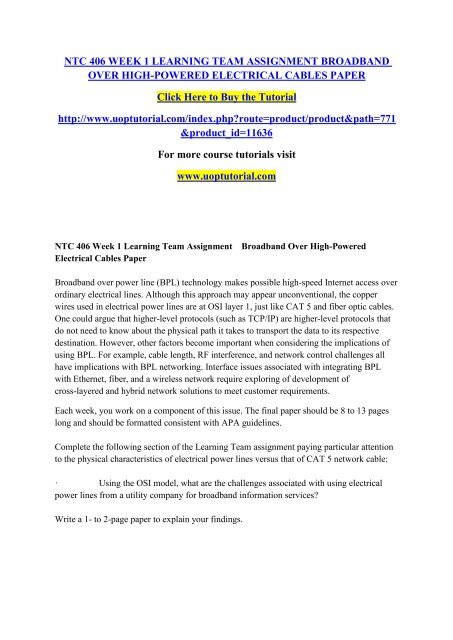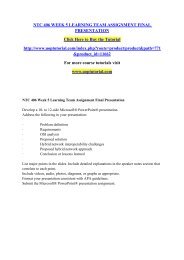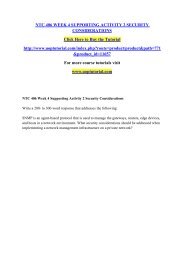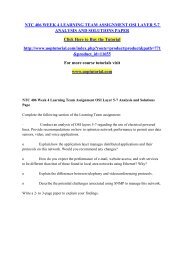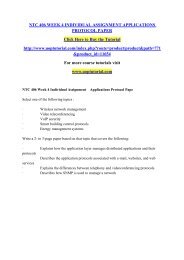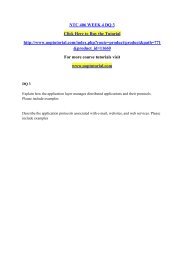NTC 406 WEEK 1 LEARNING TEAM ASSIGNMENT BROADBAND OVER HIGH-POWERED ELECTRICAL CABLES PAPER/Uoptutorial
NTC 406 Week 1 Learning Team Assignment Broadband Over High-Powered Electrical Cables Paper Broadband over power line (BPL) technology makes possible high-speed Internet access over ordinary electrical lines. Although this approach may appear unconventional, the copper wires used in electrical power lines are at OSI layer 1, just like CAT 5 and fiber optic cables. One could argue that higher-level protocols (such as TCP/IP) are higher-level protocols that do not need to know about the physical path it takes to transport the data to its respective destination. However, other factors become important when considering the implications of using BPL. For example, cable length, RF interference, and network control challenges all have implications with BPL networking. Interface issues associated with integrating BPL with Ethernet, fiber, and a wireless network require exploring of development of cross-layered and hybrid network solutions to meet customer requirements. Each week, you work on a component of this issue. The final paper should be 8 to 13 pages long and should be formatted consistent with APA guidelines. Complete the following section of the Learning Team assignment paying particular attention to the physical characteristics of electrical power lines versus that of CAT 5 network cable: • Using the OSI model, what are the challenges associated with using electrical power lines from a utility company for broadband information services? Write a 1- to 2-page paper to explain your findings.
NTC 406 Week 1 Learning Team Assignment Broadband Over High-Powered Electrical Cables Paper
Broadband over power line (BPL) technology makes possible high-speed Internet access over ordinary electrical lines. Although this approach may appear unconventional, the copper wires used in electrical power lines are at OSI layer 1, just like CAT 5 and fiber optic cables. One could argue that higher-level protocols (such as TCP/IP) are higher-level protocols that do not need to know about the physical path it takes to transport the data to its respective destination. However, other factors become important when considering the implications of using BPL. For example, cable length, RF interference, and network control challenges all have implications with BPL networking. Interface issues associated with integrating BPL with Ethernet, fiber, and a wireless network require exploring of development of cross-layered and hybrid network solutions to meet customer requirements.
Each week, you work on a component of this issue. The final paper should be 8 to 13 pages long and should be formatted consistent with APA guidelines.
Complete the following section of the Learning Team assignment paying particular attention to the physical characteristics of electrical power lines versus that of CAT 5 network cable:
• Using the OSI model, what are the challenges associated with using electrical power lines from a utility company for broadband information services?
Write a 1- to 2-page paper to explain your findings.
- No tags were found...
You also want an ePaper? Increase the reach of your titles
YUMPU automatically turns print PDFs into web optimized ePapers that Google loves.
<strong>NTC</strong> <strong>406</strong> <strong>WEEK</strong> 1 <strong>LEARNING</strong> <strong>TEAM</strong> <strong>ASSIGNMENT</strong> <strong>BROADBAND</strong><br />
<strong>OVER</strong> <strong>HIGH</strong>-<strong>POWERED</strong> <strong>ELECTRICAL</strong> <strong>CABLES</strong> <strong>PAPER</strong><br />
Click Here to Buy the Tutorial<br />
http://www.uoptutorial.com/index.php?route=product/product&path=771<br />
&product_id=11636<br />
For more course tutorials visit<br />
www.uoptutorial.com<br />
<strong>NTC</strong> <strong>406</strong> Week 1 Learning Team Assignment<br />
Electrical Cables Paper<br />
Broadband Over High-Powered<br />
Broadband over power line (BPL) technology makes possible high-speed Internet access over<br />
ordinary electrical lines. Although this approach may appear unconventional, the copper<br />
wires used in electrical power lines are at OSI layer 1, just like CAT 5 and fiber optic cables.<br />
One could argue that higher-level protocols (such as TCP/IP) are higher-level protocols that<br />
do not need to know about the physical path it takes to transport the data to its respective<br />
destination. However, other factors become important when considering the implications of<br />
using BPL. For example, cable length, RF interference, and network control challenges all<br />
have implications with BPL networking. Interface issues associated with integrating BPL<br />
with Ethernet, fiber, and a wireless network require exploring of development of<br />
cross-layered and hybrid network solutions to meet customer requirements.<br />
Each week, you work on a component of this issue. The final paper should be 8 to 13 pages<br />
long and should be formatted consistent with APA guidelines.<br />
Complete the following section of the Learning Team assignment paying particular attention<br />
to the physical characteristics of electrical power lines versus that of CAT 5 network cable:<br />
· Using the OSI model, what are the challenges associated with using electrical<br />
power lines from a utility company for broadband information services?<br />
Write a 1- to 2-page paper to explain your findings.


